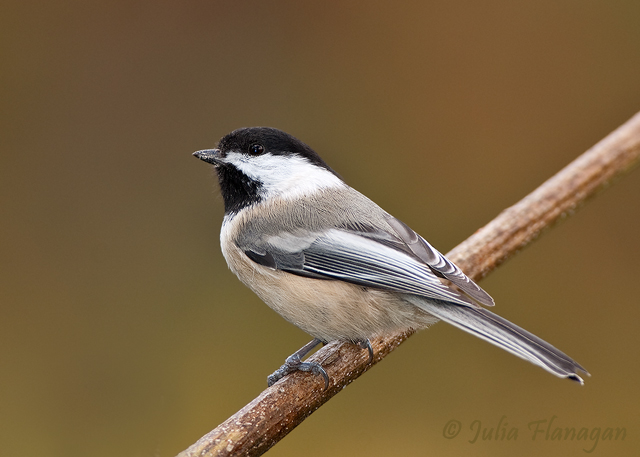
| Photos: Top © Julia Flanagan; North Chagrin Nature Reservation, Cleveland, OH; November 2010 |
Black-capped Chickadee Poecile atricapilla Order - Passeriformes; Family - Paridae A chickadee's black cap and bib; white cheeks; gray back, wings, and tail; and whitish undersides with buff to rusty flanks are distinctive among these small birds. It also has a short neck and a small bill, so that it looks very compact and "cute". However, the Black-capped Chickadee is one of two species in Virginia that are difficult to tell apart. This species is an inhabitant of the northern forests of North America, including those of the Appalachian mountains, so that it usually comes into the Piedmont and lowlands only in the winter, while the more southern Carolina Chickadee is a year-round resident. Both birds use the "chick-a-dee-dee" warning call, but the mating song of the Black-capped is lower in pitch and two notes long –"fee bee". It also tends to be browner on top and orangish along the sides, and its tail feathers have whitish edges. The chickadee feeds on insects, seeds, nuts and berries, and can be found wherever there are large trees. It is a curious animal, often coming to investigate the activities of nearby humans, so it will also come to feeders. In the winter, chickadees tend to join in a group with other small birds, such as nuthatches, Downy woodpeckers and kinglets. The chickadee will not stay on the feeder but will take a sunflower seed to a tree branch to open and eat it. There is a also a system of dominance within the species, so that the lower-ranking birds will yield the feeder site to a more dominant one, or wait for it to finish getting food before they start. They sleep in tree cavities, digging out one in a dead tree or using an old Downy Woodpecker nesting hole. They do the same for their own nests, both birds of a pair helping to excavate a hole in a place selected by the female, often in a birch or alder tree. The female builds the cup-shaped nest, using moss and other plant material, and lines it with softer material such as rabbit fur. Black-capped Chickadees will use a nesting box that is filled with sawdust or wood shavings. About half a dozen small white eggs are laid. Black-capped Chickadees are found from the central Rocky Mountains and the Pacific NW in the US north to subarctic Canada and Alaska, and from the northern Midwest to New York and New England and north into Canada, as well as south from Pennsylvania along the Appalachian highlands. Where this range overlaps that of the Carolina Chickadee, the two species may mate to produce hybrid birds that have an intermediate appearance and a song of three syllables instead of two or four. |





